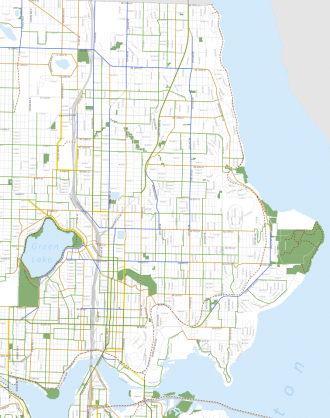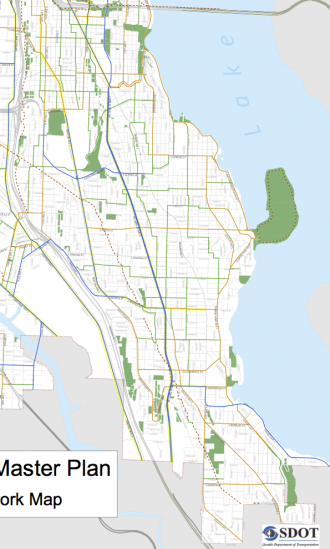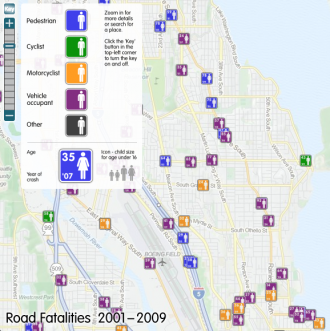
This is the fifth post in a series analyzing Seattle’s draft Bicycle Master Plan update. The deadline to comment on the draft map is today (January 31). This post will focus on the Northeast and Southeast neighborhoods.
Northeast Seattle
Northeast Seattle, which for the sake of this post is anything east of Aurora and north of the Ship Canal, is already home to many of the city’s most bikey neighborhoods.
Cycling in the area has been anchored by the Burke-Gilman Trail for decades, and residents have in recent years been building momentum for more intra-neighborhood connectivity to help families get to schools, parks and local commercial destinations safely and easily. It’s due to this work that several of the area’s schools—like Bryant and Eckstein—are leaders in the city-wide bike-to-school revolution.
The neighborhood has ambitious neighborhood greenway goals. Wallingford was among the first neighborhoods in the city to form a resident-led neighborhood greenway group thanks to the tireless work of Cathy Tuttle. Wallingford is also the site of the first new-era neighborhood greenway on N 44th/43rd Streets. Nearby, another neighborhood greenway recently opened on 39th Ave NE thanks in large part to Seattle Children’s, which has more livable streets work on the way (stay tuned!).
So what are the bike facility priorities for the neighborhood? I asked Clint Loper and Andres Salomon, who are active in schools and greenways efforts in the area, and boiled their responses down to this:
- Safe ways to cross I-5
- Arterial intersection improvements
- Burke-Gilman access and safety improvements
I-5 is, hands down, the biggest impediment to biking and walking in northeast Seattle. For example, there is no truly safe way to cross the freeway south of Ravenna Blvd and north of the Burke-Gilman Trail: That’s 22 blocks separating some of the densest, bikiest and walkiest neighborhoods in the entire city. There is room for debate on how best to do this (the 2007 BMP had a separate biking and walking bridge over I-5, though we have argued in the past for a much cheaper 45th St cycle track and walking-friendly redesign). But the point is clear: This cannot wait longer.
The draft BMP appears to understand this point, and calls for cycle tracks on I-5 crossings at 45th, 50th, 65th, 80th, 130th as well as the biking and walking overpass at the upcoming Northgate Station.
If there are potential sources of controversy in northeast bike projects, it’s likely to be in regards to these key east-west streets. They are simply the only options for crossing I-5. Neighborhood greenways can do heavy lifting for intra-neighborhood travel, but until we invent a safe bicycle catapult or stumble into many tens of millions of dollars dedicated to new overpasses (which would be very cool), the arterial streets are the best options for improving mobility and safety for east-west trips. It is good to see the draft plan already include these connections.
The next biggest need is for more safe crossings of those clogged and frustrating east-west streets. There are many excellent options for biking and walking north-south in the neighborhood, but nearly all of them become unusable due to busy and poorly-designed streets like Green Lake Way N, 50th St, 65th St, Lake City Way, and on and on. Some of these streets could be excellent candidates for a complete streets upgrade. For other intersections, improved crossings will be needed on a spot-by-spot basis.
Finally, the Burke-Gilman itself could be even more useful if there were more safe and easy neighborhood connections. There are also crossings (especially in the University District) that are not very safe and segments that are either destroyed by tree roots or too skinny to fit current (and future) traffic levels. The University of Washington does have a plan for improvements that should address these issues, but this should be considered a city-wide and even regionally-significant issue.
Here is an excellent report from the Seattle Bicycle Advisory Board’s NE bikeability tour last year:
Southeast Seattle
 Southeast Seattle, which for the sake of this post is anything east of I-5 and south of I-90, has long been neglected by the city’s bicycle facility efforts. Many of the city’s most dangerous streets—whether you bike, walk or drive—are in the southeast.
Southeast Seattle, which for the sake of this post is anything east of I-5 and south of I-90, has long been neglected by the city’s bicycle facility efforts. Many of the city’s most dangerous streets—whether you bike, walk or drive—are in the southeast.
The area is dominated by the very people-unfriendly Rainier Ave. The street divides neighborhoods all along its length, and is one of the most dangerous streets in the entire city. A shocking number of people die from traffic collisions on the street, and many of those killed are over 70 years old.
The draft BMP does not include any changes to Rainier Ave south of its intersection with MLK. While changes to Rainier would certainly be the most controversial project in southeast Seattle, it also has the greatest potential to revolutionize not only the bikeability of southeast Seattle, but also dramatically increase walking safety.

However, with LINK Light Rail accelerating changes and rent increases in the Rainier Valley, many active residents are understandably wary of transportation changes that seem to be placed on top of the neighborhood by the city. A road diet on Othello St last year turned controversial, for example, and the debate over relationship between bike lanes and gentrification is very much unresolved.
On one hand, safe bike facilities do make commercial districts and neighborhoods more desirable. On the other hand, it is simply unjust that lower-income populations should be centered around our most dangerous streets and bear a disproportionate number of traffic deaths. And, nationwide, the poorest quarter of the population depends on cycling for transportation more than any other economic segment. And while white people bike at slightly higher rates than their share of total population, the difference is within a few percentage points.
The Bicycle Master Plan update is a 20-year plan, and I find it hard to imagine a bikeable and walkable 2033 southeast Seattle that does not include a dramatically redesigned Rainier Ave, and a safe bicycle facility should be part of that vision.
Ah, so many words already in this post, and we haven’t even touched on Beacon Hill or the Lake Washington Loop yet!
Beacon BIKES continues to do fantastic community work to develop a vision for making their neighborhood easier and safer for biking and walking. Their community-developed neighborhood circulation plan gives a fantastic blueprint for city investments, and much of that work is represented in the BMP (which is great!).
A safe and convenient way to connect the Mountains-to-Sound Trail to the International District and downtown is a vital missing link in the plan, and there could also be ways to connect the trail (and neighborhood) to Sodo at various points.
Among the weakest links in the entire Lake Washington Loop bike route is in Southeast Seattle. The plan includes a cycle track on Rainier Ave from the city border to Henderson, which would connect the route to Seward Park Ave. Seward Park Ave, however, is one of the worst segments of this route, which should be treated as a route of regional significance. The draft plan calls for “minor separation” on Seward Park Ave, but this seems like an opportunity to do much more.
And though it is not within the city limits, working with Tukwila to connect South Park and Rainier Beach should be considered a vital element to the future of cycling in the south end of the city.
Here is a report from the Seattle Bicycle Advisory Board’s study of SE Seattle last year:
Whew, this was quite a marathon post with far more elements worthy of covering. What are the biggest elements I missed? Let us know in the comments. And, of course, submit your thoughts to the city.








Comments
11 responses to “Bike Master Plan: NE and SE Seattle”
Maybe I’m missing something — but that BMP map claims there is “In street, major separation” along MLK. Last I was there (15 minutes ago) there is no such thing — it’s one of the scariest possible roads to ride on (despite its wonderful, wonderful mostly flatness). Why does the map claim there are bicycle facilities there? Anyone know?
That’s the draft Master Plan Map. Markings on the map indicate what the bike facility map should look like in 20 years, not the way it looks today. The city has been searching for feedback on the map, which is still in development.
Thanks. That’s what I missed!
Still just a little cranky that something wasn’t put in when they ripped up the street for the light rail in the first place … wouldn’t that have been wonderful?
I completely agree. That was a huge missed opportunity.
BMP isn’t worth the paper it will be printed on.
Pointless lines on a map…weeeee.
Well, that depends on how effective the effort is to keep the city on task regarding the plan. One of the key points during that NE Seattle Bikeability tour was that the city is not meeting it’s stated goals from the earlier version of the plan. Cascade and the SBAB repeatedly emphasized on the ride (and Tom here on this blog) that providing this feedback on the BMP is important but even more so is making sure that city and SDOT put their money where their stated goals are and direct more funding towards realizing the BMP. Get in touch with your council representatives, the Mayor’s office, SDOT, attend meetings and make your voice heard.
Sure SE Seattle lacks bike infrastructure. I am sure they truly need greenways there, but they do have Link Light rail where you can roll your bike on and get downtown or up and down the corridor in no time at all. On the other hand, West Seattle is around 6 miles from downtown, a very bikeable commute. West Seattle’s Metro commute times have not improved and in many cases have gotten worse since the Metro 29 September restructure. “Rapid” Ride is still held hostage by traffic signals and peak hour traffic jams. During rush hour West Seattle suffers some of the worst traffic congestion in the city. The quickest way to get downtown at those times from many locations in West Seattle is by bicycle. Yet many potential bike commuters are scared off by the lack of safe bike infrastructure on the few routes in and out of West Seattle. With something like 2,000 new units being added in West Seattle, many with parking spaces, it is a matter of urgency to plan better bike infrastructure to connect West Seattleites to their destinations outside the peninsula. http://westseattleblog.com/2012/12/west-seattle-development-mapped-2000-planned-units-2
The masses will never be able to bring bikes on transit. There just isn’t room on the vehicles. Instead we need to do what cities where biking and transit really work do: build lots of space-efficient, covered, and reasonably secure bike parking near major transit nodes.
Bike lockers as we have them aren’t space efficient, partly because they have to be used by the same person every day, which lowers utilization. More flexible day-use lockers would be pretty cool… apparently BART has them, we should consider it, too. Outside of lockers, security of daytime bike parking in places with lots of pedestrian traffic isn’t an impossible challenge, and goes hand in hand with covered parking. One of the security problems with the bike parking near the Montlake Flyer Stop is that it’s so easy to approach the area out of view of the sidewalk. A roof structure could limit access to visible entry points.
Ah, I see the BMP calls for a cycle track on Green Lake Way… that just plain stops at 50th. The cycle track picks up again on E Green Lake Way at W Green Lake Way, and on 50th at Latona, but there are big gaps on both routes unless you count the bike lanes on E Green Lake Way (and I guess the ones on Latona and Thackeray, but that seems like a comparatively minor corridor to start the 50th cycle track at).
[…] stretch of street as a candidate for safety improvements, and the draft Bicycle Master Plan update recommends the street for a safety […]
[…] During review of the first draft of the Bike Master Plan, we said this: […]